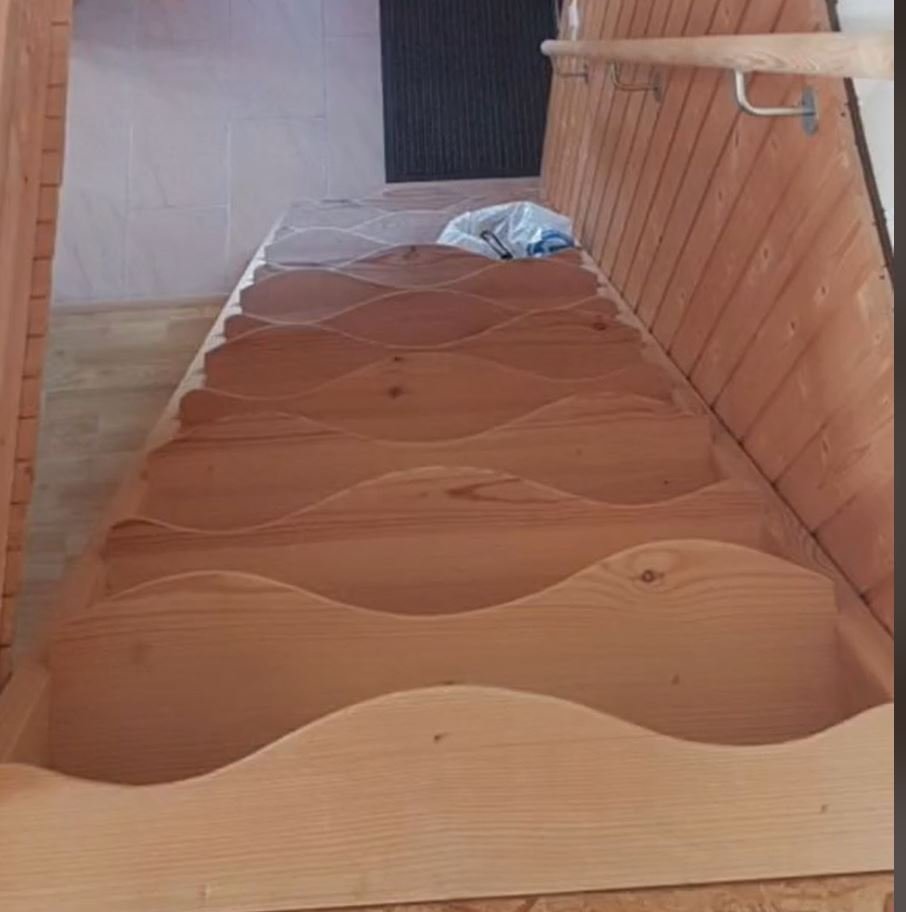Witches’ stairs are a strange but interesting design feature that became popular on TikTok a couple of years ago. Even though they have an unusual history, their name doesn’t really have to do with superstition. Instead, these stairs are a clever design choice. When made and installed correctly, they can be both useful and nice to look at!
Witches’ Stairs aren’t what they Appear.

While the stories about witches’ stairs might sound more interesting, they actually have a very practical purpose. They are really useful in homes with little space, like attics, lofts, and tiny houses. Witches’ stairs are designed to save space while still allowing you to go from one floor to another. Architects often call them “alternate tread stairs.”
How Witches’ Stairs Function

Photo Credit: itsthatrealestatechick | TikTok
Witches’ stairs are designed to save space in two ways. First, each step is only half as wide as regular steps, and the steps are staggered. This makes the staircase narrower than a traditional one. These smaller stairs can also be used for extra storage, like for books or displaying items. According to Scott Schuttner, who wrote “Basic Stairbuilding,” the distance between the steps on one side of an alternating-tread stair is twice the height of the rise, which gives you more space on the steps and makes them safer.
Besides being practical, witches’ stairs meet building codes and safety standards in the U.S. A standard staircase is usually 3 feet wide, while a residential witches’ staircase is typically between 27 and 30 inches wide.
Real Origins

Photo Credit: itsthatrealestatechick | TikTok
In 1985, a businessman named J.M. Lapeyre created a metal version of witches’ stairs. He thought these stairs could be a safe alternative to ladders in commercial and warehouse settings, especially in tight spaces where ladders might not be safe. This design is also used on commercial ships and oil rigs, and it can be called ship stairs or ship ladders, in addition to witches’ stairs and alternate tread stairs.
Misconception

Photo Credit: itsthatrealestatechick | TikTok
When videos of witches’ stairs first appeared on TikTok in 2021, they were linked to an urban legend. According to this legend, these staircases were built in 17th-century Massachusetts to keep witches away during the Salem witch trials because “witches can’t climb up them.” This idea has been proven false, but another rumor suggests that Thomas Jefferson came up with the design. Because of this, witches’ stairs are sometimes called Jeffersonian or Jefferson stairs. However, an original version of the design was also mentioned in a book called “Monckton’s One Plane Method Of Hand Railing and Stair Building,” published in 1888.
Debunking the Myth

Photo Credit: conspiracy___time | TikTok
The exact origins of witches’ stairs are a bit unclear, but one thing is clear: there’s no historical evidence that they were designed to keep witches away. Historian Robin Briggs has studied many historical sources and found no mention of stairs that could disable witches. Interestingly, some people with these unique staircases also buried “witch bottles” or included dead cats in their homes for protection against witchcraft, but Briggs calls this idea “pure disinformation.” He notes that the closest belief was that putting a broom over the door would trap a witch inside.
While it’s fun to think about myths and legends, it’s also interesting to know the real history of witches’ stairs. Regardless, they offer a unique and decorative alternative to regular staircases, adding a fun and quirky touch to home design.
Poor Woman Buys Old Stroller for Her Baby and Finds an Envelope Inside — Story of the Day

When Mariam bought a second-hand baby stroller for her daughter, she thought she was merely salvaging what little hope life had left her. But inside the tattered buggy lay something unexpected. An envelope that would change everything.
The road shimmered in the heat of the midday sun as Mariam pushed the second-hand baby stroller she’d just bought for a steal.
Her eyes stung, and tears trickled silently, splattering onto her trembling hands.

A close-up shot of a woman’s eyes | Source: Pexels
She looked down at the stroller. It had worn-out handles, faded fabric, and scuffed wheels. It wasn’t something she would’ve ever wanted for her baby, but life had other plans.
Before this cruel twist of fate, Mariam had been a different woman.
She dreamed of pink nurseries adorned with soft toys, tiny dresses neatly folded in a white oak dresser, and a crib that would rock her baby to sleep.
And a stroller that was supposed to be beautiful.
But Mariam’s dreams had shattered, blown away like dust in the wind.

A woman standing outdoors | Source: Midjourney
The memories of her high school days drifted into her mind as she walked.
That’s when she’d met John. They fell in love quickly, sharing dreams of a simple life together.
Soon, John proposed with a modest ring, and Mariam didn’t care that they had little to their names.
After their wedding, they moved into a small apartment. Mariam worked in the warehouse of a clothing store while John worked as a cashier at a local grocery store.
They didn’t have much, but they made it work.

A couple holding hands | Source: Pexels
Late-night laughter and cheap dinners carried them through until the day Mariam saw two pink lines on a pregnancy test.
John was super happy after learning about their baby, and so was Mariam.
From that day on, John worked twice as hard. He picked up double shifts, leaving for work before the sun rose and coming home after Mariam had fallen asleep.
Mariam continued working, too, until her swollen belly made it impossible.

A pregnant woman | Source: Pexels
Together, they pooled their savings, pinched every penny, and finally bought a small house. Holding the keys to their new house, they stood in the doorway, teary-eyed and grateful.
“Can you believe it, John?” Mariam whispered. “We did it. We made it.”
John kissed her forehead. “This is just the beginning, Mariam.”
But Mariam didn’t know then that life was waiting to take everything back in an instant.
It all happened on an ordinary Tuesday evening.

A woman standing in her living room | Source: Midjourney
Mariam was seven months pregnant when she walked into the hospital for a routine scan. She had been there countless times before, but something about that day felt different.
The doctor glanced around the room. “Where’s your husband today, Mariam?”
“Oh, he couldn’t come,” Mariam replied with a smile. “He’s working a double shift. He wanted to be here, but we need the money.”
The doctor nodded, continuing with the ultrasound as Mariam lay there, blissfully unaware of the storm brewing outside.

A doctor doing an ultrasound scan | Source: Pexels
An hour later, as Mariam stepped out of the hospital and into the bright afternoon sun, her phone rang. The number on the screen was unfamiliar, but she answered it.
“Hello?”
“Is this Mariam?” A voice on the other end asked, serious and clipped.
“Yes. Who’s this?”
“I’m calling from the STSV Hospital. Ma’am, your husband, John, has been in an accident. You need to come here immediately.”
Mariam froze. The ground seemed to shift beneath her feet.

A woman using her phone | Source: Pexels
“N-N-No, you’ve got it wrong,” she stammered, clutching the phone tightly. “My husband just called me… an hour ago. It can’t be him. You’re mistaken!”
“I’m sorry, ma’am, but we need you to come as soon as you can,” the voice repeated.
Her heart slammed against her chest as she staggered backward, her legs giving way beneath her. A dull ringing filled her ears as the phone slipped from her hands. People hurried past, staring, but Mariam didn’t see them.
Everything around her blurred into nothingness.

The hallway of a hospital | Source: Pexels
When she opened her eyes again, Mariam was lying in a sterile white hospital room. The hum of machines surrounded her.
And then she felt it as her hands drifted to her stomach. Her bump was gone.
“No!” she cried out, bolting upright. “Where’s my baby? Where’s my baby?”
A nurse rushed to her side. “Calm down, Mariam. Your baby is safe.”
“Safe? What happened? Where is she?”
“You collapsed outside the hospital. We had to perform an emergency C-section to save the baby. She’s premature, but stable in the NICU.”

A newborn baby’s feet | Source: Pexels
She felt relieved, but the feeling faded as soon as she thought of John.
“Where’s John?” she whispered hoarsely. “Where’s my husband?”
The nurse hesitated. “He’s… he’s safe, Mariam. He’s in a nearby hospital. He’s been injured, but you’ll be able to see him soon.”
As soon as she was strong enough to leave her bed, Mariam demanded to see John. A doctor escorted her to the hospital where he’d been taken.

A woman standing in a hospital room | Source: Midjourney
That’s where she learned something that turned her world upside down.
“Mrs. Green, I’ll be honest with you,” the doctor said gently. “Your husband’s injuries were severe. The accident damaged his spine… he’s paralyzed from the waist down.”
When she met him in the hospital room, the look on his face told her he knew everything. So, she decided to stay strong for him and told him everything was going to be okay.
She told him they’d manage everything even if he couldn’t walk.

A woman in a hospital | Source: Midjourney
But John just stared at the wall as she talked to him. He didn’t even respond when she told him about baby Heidi.
After a few weeks, she brought John and Heidi home.
John sat silently in his wheelchair, his once-bright smile replaced by a heavy frown. The man who had once worked tirelessly for their future now barely spoke.
Mariam didn’t blame him. How could she? But she knew she had no choice. With John unable to work, it was up to her to keep their family afloat.

A man in a wheelchair | Source: Pexels
A week later, she was back at the warehouse, working long shifts to earn whatever she could. Sleepless nights caring for Heidi were followed by grueling days on her feet, but Mariam kept going.
One afternoon, as she counted the last few crumpled bills in her purse, she knew she had to buy something for her baby girl. She wanted to buy a stroller because carrying her baby everywhere was wearing her down.
So, she decided to visit the flea market that day.

A flea market | Source: Pexels
The market bustled with life as Mariam walked slowly with Heidi in her arms. Soon, her gaze landed on a baby stroller tucked between an old rocking chair and a stack of dusty books.
The frame was sturdy, the wheels still turned, and the faded fabric looked clean enough. It wasn’t brand new, but it would do.
“How much?” she asked the vendor.
“Ten dollars,” the man replied.
Mariam exhaled in relief. She handed over her last ten-dollar bill.

A woman giving a $10 bill to another person | Source: Pexels
Then, she brushed Heidi’s hair with her fingers and smiled.
“Ah, finally, sweetie,” Mariam cooed. “Mommy got you a new buggy. We’ll go home, clean it up, and then you can rest in it, alright?”
Once home, Mariam set Heidi on the couch and carefully inspected the stroller. It needed a good dusting, so she grabbed a rag and started wiping it down.
As her cloth ran over the padded seat, she heard the sound of something crackling.

An old stroller | Source: Midjourney
“What is that noise?” Mariam muttered, stopping. She ran her hand over the seat again and heard the same faint crunching sound.
“Is there something… inside?”
Mariam’s fingers dug into the edges of the padded seat, tugging it free. Her breath hitched when she felt something hard tucked beneath it.
“What on earth?”
John, seated nearby, glanced at her curiously. “What’s going on?”
“I… I don’t know.” Mariam’s voice trembled as she pulled out an envelope. It was thick, crinkled, and sealed tightly.
Her eyes widened as she read the words scrawled across it.

A sealed envelope | Source: Pexels
From one poor mother to another.
Mariam’s hand trembled as she tore open the envelope.
“Oh my…” she said as her gaze landed on what was inside.
The envelope had ten $100 bills.
Behind them was a folded piece of paper. When Mariam unfolded it, she realized it was a letter.

A woman reading a letter | Source: Pexels
“You probably bought this stroller because you’re not experiencing the best times in your life,” she read aloud. “Well, everybody has hard times, but you need to have hope because no storm is permanent. Here’s a little help from me to you. If you don’t wish to take it, you can always think of others in need of this money more than you. Decide wisely, and if you still do not want this money, then send it to the homeless shelter’s address mentioned here.”
John wheeled closer and looked at the $100 bills.

A man holding $100 bills | Source: Pexels
“There’s a lot of money here,” he said quietly. “Who leaves money in an old stroller?”
“I don’t know,” Mariam replied, shaking her head.
Then, her gaze landed on her baby girl, and she thought of keeping the money for a moment.
But then a pang of guilt gnawed at her heart.
“At least I have a home and something to eat,” she murmured. “There are people who need this more than I do.”
“What are you talking about?” John frowned. “Mariam, we can’t just give it away. Do you know what this could mean for us?”

A man in a wheelchair | Source: Midjourney
“I know, John,” she said. “But I also know there are families out there with nothing. I’ll send it to the shelter tomorrow. It’s the right thing to do.”
The next morning, Mariam tucked the envelope into her purse and mailed it to the address in the note. She returned home with a strange peace in her heart, though John’s disappointment lingered silently between them.
Weeks passed. Life continued, hard as ever, until one afternoon, there was a knock on the door. Mariam opened it and gasped.

A close-up shot of an open door | Source: Pexels
Standing on the doorstep was an older woman in expensive clothes, her presence striking and unexpected.
“Hello there,” the woman said with a kind smile. “I’m Margot.”
“Uh, hi,” Mariam said. “Can I help you?”
“I hope you like the stroller you bought.”
“The stroller?” Mariam asked with wide eyes. “How did you know?”
“I had that stroller before,” Margot said. “And I put the $1,000 in it.”
“It was you?” Mariam asked. “Oh my God… Thank you so much for your kindness, but I didn’t keep the money. I—”

A woman looking straight ahead | Source: Midjourney
“I know what you did with it, Mariam,” Margot said. “That’s why I’m here.”
“Please come in,” Mariam said, unsure of how the woman knew her name.
As Margot stepped inside the house, she glanced around at the peeling paint and old furniture. Then, she told Mariam why she was there.
“You see, dear, my husband and I tried for years to have a child,” Margot began. “When we finally had our daughter, she was the light of our lives. But she was taken from us far too soon. I thought I’d never find purpose again after losing her… and then my husband passed, too.”

A close-up shot of a woman crying | Source: Pexels
“I’m so sorry,” Mariam whispered, her heart aching for the woman.
“Before my husband died, he told me, ‘Darling, don’t let the world blind you. Not all that glitters is gold. There are people out there with true hearts of gold.’” Margot continued. “Those words stayed with me. So, I began a little experiment. I hid money in timeworn items at flea markets, leaving notes behind to see who would take it.”
“You did all that to… test people?” Mariam asked.

A woman sitting on a couch | Source: Midjourney
“No,” Margot said. “I did that to find someone who’d prove that honesty still exists. And you did that.”
“But I just did the right thing,” Mariam said.
“And that’s exactly why I’m here,” Margot announced. “I run one of the largest apparel brands in the country. I’ve been looking for someone trustworthy, someone deserving, to help run my company. You’ve proven you’re that person.”
Run her company? Mariam thought. Am I dreaming?

A woman looking straight ahead, thinking | Source: Midjourney
It was only a matter of a few moments that Mariam realized Margot wanted to hire her because of her honesty. She told Mariam there would be a training program after which Mariam would be able to join the company.
Margot even offered a pay that Mariam thought was too good to be true.
“Here are my contact details,” Margot said as she extended her visiting card to Mariam. “Call me when you’re ready, okay?”
“Thank you,” Mariam said. “I’ll definitely call you.”

A woman standing in her living room, looking straight ahead | Source: Midjourney
And that was the day Mariam’s life changed for the better. She accepted the offer and soon enrolled in the training program that would lead her to her dream job.
She couldn’t believe how a stroller and a little bit of honesty changed her life for the better.
If you enjoyed reading this story, here’s another one you might like: When my mother-in-law destroyed the stroller we bought for our newborn son, I was furious and heartbroken. I thought it was one of her usual stunts until she revealed the chilling reason behind her actions.
This work is inspired by real events and people, but it has been fictionalized for creative purposes. Names, characters, and details have been changed to protect privacy and enhance the narrative. Any resemblance to actual persons, living or dead, or actual events is purely coincidental and not intended by the author.
The author and publisher make no claims to the accuracy of events or the portrayal of characters and are not liable for any misinterpretation. This story is provided “as is,” and any opinions expressed are those of the characters and do not reflect the views of the author or publisher.



Leave a Reply